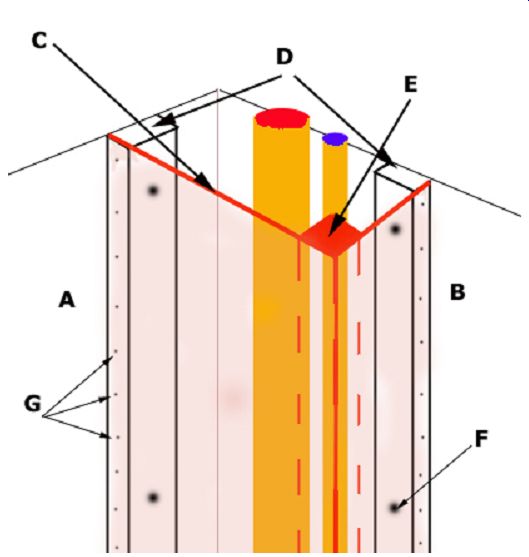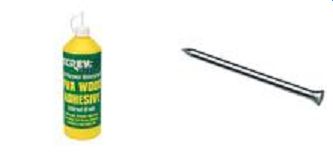BOXING IN PIPES

In the picture above you can see we have shown a simple pipe boxing. A & B represent, in this case, two walls, with the pipes fixed or running up wall B. This could just as easily be a box fixed between the wall and the floor if your pipes are running horizontally. With A representing the floor and B, the wall or skirting. The principle is the same in both cases. The materials you will use will vary depending on the size of your box but for most applications either ¼ inch plywood or plasterboard is good.
Remember as with all carpentry related projects. Measure twice-Cut once.
Read all of this project before starting work. When the two sides of your boxing meet, there will be a join. Ideally you would like this joint as discreet as possible. If you use the diagram above and the instructions below, the joint will always be seen on the same face as the board you have fixed the batten to. D represents two battens, usually 50 x 25mm is a good size although in most applications 38 x 19mm is fine. Fix these battens to the surface, as close to the pipes as possible. For masonry walls you will need a 5.5 or 6mm masonry drill bit, red wall plugs, 2 inch number 8 screws and a hammer action power drill, for plasterboard walls see our fixing to plasterboard project. For lathe and plaster walls see our fixing to lathe and plaster project.

The screws, shown as F above, should be about 400mm apart. Next you need
to measure along the line of C, I.E. from wall A, to the face of the batten
you have fixed on wall B. Then measure the length of the piece of board you
need from floor to ceiling or whatever two surfaces this box is between.
Having cut the board C you now need to fix batten E to it. The size of this
batten again depends on the size of your boxing but normally 38 x 38mm is
fine. Batten E is cut to the same length as your boxing and maybe just a
mm or so longer. This will give it enough length to fit tightly between the
two surfaces and give the boxing greater strength. Be careful not to cut
it too long and damage the ceiling or walls as you push it into position.
The batten can be fixed with either screws or panel pins, but whatever you
use for any of the surface fixings, remember you may need to decorate so
get the heads of the fixings slightly below the surface of your box. The
holes can be filled later. We always use a little wood glue on these joints
as well.

Having fixed board C to batten E place them in position against the batten
on wall A. A little glue and some panel pins or screws (as shown by G) will
hold the board in position together with the tightness of batten E "wedged" into
position. Next cut the other side of the board and glue, pin or screw into
position. If you are using plasterboard for your boxing then its best to
use drywall screws as they are guaranteed not to rust and bleed through either
your plaster or paint. Fill all the screw holes and pin holes and you can
then run around the edges with some decorators caulk ( Flexible filler in
a tube applied using a sealant gun) to hide the joints between box and walls/ceiling.
If this box is in a bathroom and you intend to tile it, use an undiluted
coat of PVA adhesive to paint the boxing before you tile. This allows the
tile adhesive to stick properly on the surface you have used.